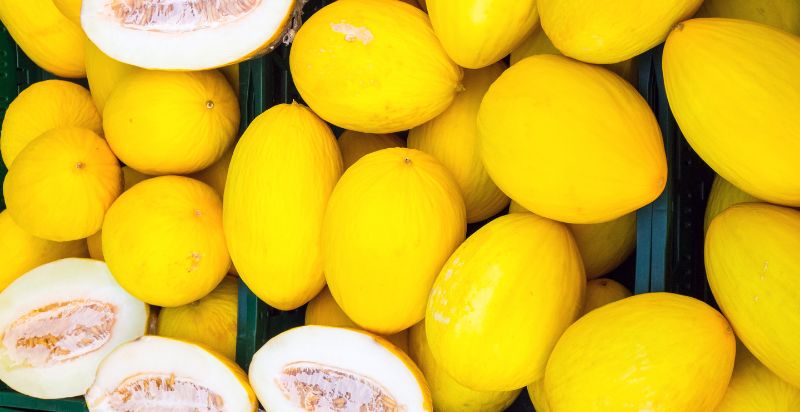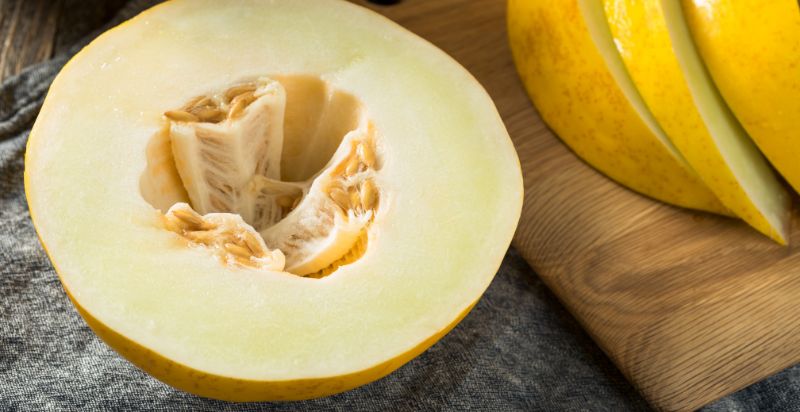Canary melon, also known as winter melon, has a sweet, mild flavor and bright yellow flesh. It is native to South America but is now widely cultivated in other regions and comes in many shapes, sizes, and varieties.
The canary melon has a thick skin ranging in color from yellow to orange and a sweet, light flavor that makes it a perfect addition to salads, smoothies, or even just eaten as is. Here is everything you need to know about the canary melon.
What is a Canary Melon?
Canary melon is a type of Melon that belongs to the Cucurbitaceae family. It has a sweet and mild flavor with bright yellow flesh. Canary melons have many shapes and sizes, ranging from round to oblong. The skin of the canary melon can range in color from yellow to orange, and it has a thick rind that is easy to peel.

The History and Origin of the Canary Melon:
The canary melon is a variety of melons first developed in the United States during the late 19th century. It is a cultivar of Cucumis melo and belongs to the same family as watermelon, honeydew, and cantaloupe.
This melon gets its name from its bright yellow color, similar to a canary bird’s. It is native to North America and is grown throughout the United States, Canada, Mexico, and South America.
When ripe, the canary melon is large and typically weighs about 2 to 3 pounds. It has a round, oblong shape; its skin is thin and smooth with a bright yellow hue. Its flesh is also bright yellow and offers a juicy sweetness when eaten.
Health Benefits of Canary Melon:
Canary melon is a good source of vitamins A, C, K, and B6. It is also high in minerals such as potassium and magnesium. This type of melon can help to regulate blood pressure, improve eyesight, strengthen bones and teeth, boost the immune system, and aid digestion. In addition to providing essential vitamins and minerals, it is also rich in polyphenols and dietary fiber, which can help reduce the risk of disease.
How to Select and Store Canary Melon:
When selecting a canary melon, look for even-colored yellow skin without bruises or discoloration. Avoid those with soft spots or wrinkles, as these indicate that the melon is overripe. It would help if you also gently squeezed the melon to ensure that it is ripe and not too hard.
Once you have selected your melon, store it in a cool place away from direct sunlight for up to one week. Cut the melon in half when ready to eat, and scoop out the seeds. The flesh can either be eaten raw or cooked.

Where are Canary Melons Grown and Harvested?
Canary melons are primarily grown in tropical and subtropical regions, such as Brazil, the Caribbean, Central America, South America, and Mexico. It is mainly cultivated in North America in California, Arizona, Texas, and Florida. They are harvested when they have reached their full size and coloration, generally 2 to 3 weeks after blooming.
As with most melons, they should be picked when the stem easily separates from the vine. After harvesting, canary melons keep in cool temperatures for several weeks without losing flavor or texture. Once cut, the canary melon should be stored in an airtight container and consumed within a few days for optimum freshness.

Flavor Profile of the Canary Melon:
The Grown melon has a sweet, juicy, and slightly tart flavor. Its texture is firm but succulent, with a mild aroma of honeydew and cantaloupe. The taste of this variety can vary depending on where it was grown, but generally, it has a refreshing sweetness that lingers on the tongue. It’s a great choice for various dishes, from salads to desserts and drinks.
The subtle balance of sweet and tart makes it a perfect pairing with many other fruits and spices. Enjoy this melon as part of your daily routine for extra flavor.
Where to Find the Best Quality Canary Melon?
The best place to find high-quality Canary melon is at your local farmer’s market or specialty produce store. You can also look for online stores specializing in heirlooms and organic fruits and vegetables. It’s important to buy from reputable sources, as the fruit’s quality will reflect how it was grown and handled.
Look for melons that have a bright yellow color, are firm to the touch, and are free of blemishes. When selecting your melon, be sure to evaluate its size and shape. The larger the fruit, the higher quality it will be. Finally, smell your it before purchasing – it should have a sweet, fruity aroma.
How to Store Canary Melon?
The canary melon should always be stored in the refrigerator. It is best to place them in a plastic bag and store them in the crisper drawer of your refrigerator. They will keep for up to two weeks when stored this way.
If you plan on keeping them longer, it is best to freeze them. Cut the melon into wedges, place them in a freezer bag, and freeze. They should keep for up to three months when frozen.
If you plan on using the frozen melon within the next few days, you can store it in an airtight container or a resealable plastic bag in the refrigerator.
How to Use Canary Melon in recipes?
Canary melon can be used in various recipes to add flavor and color. It can be eaten raw, diced, or sliced into salads, cubed and added to salsas, stir-fried with other vegetables, and even cooked down into jams or jellies.
When slicing the melon, keep the rind on as it will help retain moisture during cooking. For best results, cook Canary melon until just tender and avoid overcooking. It can also be used in smoothies or pureed into soups. Its mild flavor pairs well with honey, lime juice, and herbs like mint, basil, or cilantro.
Use the sweet flesh of the melon in pies, cobblers, and crumbles for a unique and flavorful dessert. When grilling or roasting vegetables, add it to the mix for a burst of color and sweet flavor.

Conclusion
Canary melon is an easy and delicious way to add a unique flavor and color to any meal. When selecting Canary melons, look for ripe and firm with a bright yellow color. Store them in the refrigerator or freezer until ready to use, and enjoy their sweet taste in salads, salsas, jams, pies, and more. With its refreshing and mild flavor, It will surely become a favorite in your kitchen!
- Everything You Wanted to Know About Red Tamarillos - June 2, 2025
- A Guide to Tulips: Everything You Need to Know & More… - June 2, 2025
- Guanabana: Description, Flavor, Benefits, And Uses - May 27, 2025

6 thoughts on “Canary Melon: Description, Flavor, And Uses”
Comments are closed.